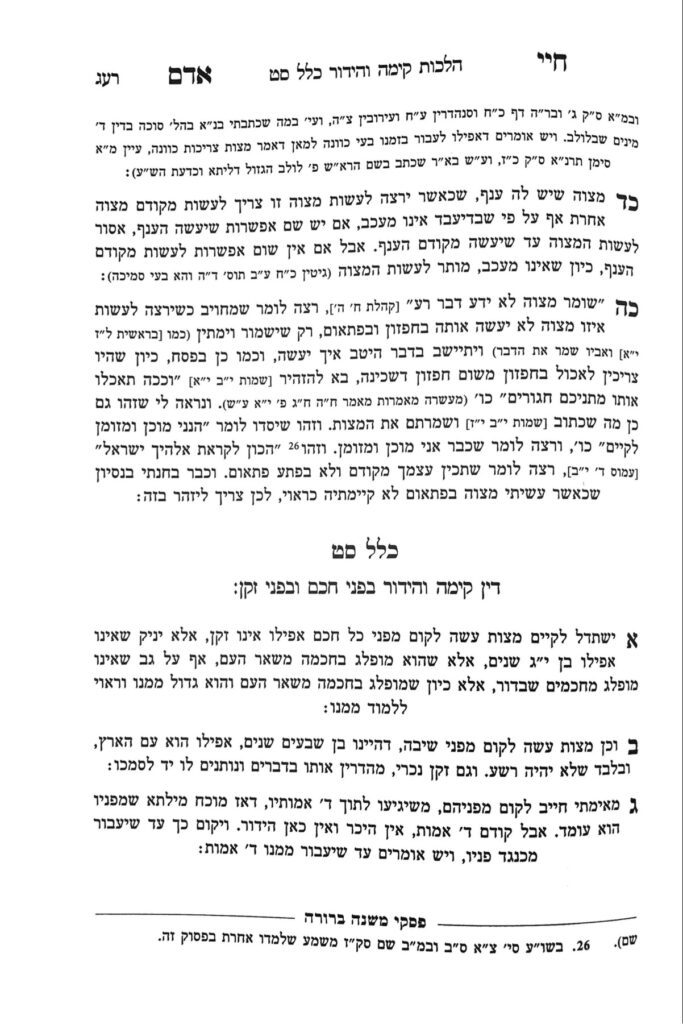We are continuing in siman 25, discussing the concept of shomeir mitzvah. We learned that the Chayei Adam understands that the hineni muchan is not the vehicle for preparation of a mitzvah, but rather, one has to give thought to the mitzvah before reciting the hineni muchan, in order to be truly ready when reciting it and not make a false declaration.
The Chayei Adam continues, and writes that the concept of the hineni muchan is based on the pasuk in Amos, hikon likras elokecha Yisrael, that Klal Yisroel should prepare themselves prior to encountering Hashem.
The Chayei Adam adds a personal note, that when he has done a mitzvah suddenly, without preparation, he has not fulfilled it properly. Therefore, he cautions that one should be careful about prior preparation.
The Gemara in Shabbos says that the pasuk of hikon regards davening. The Gemara understands the pasuk to teach us that one should put on a special garment for davening. There are two elements to this special garment. The first is that a person is giving chashivus to tefillah by having a special garment for tefillah. The second is that when putting on the garment, they are moving into a state of mind that they are about to daven
Regarding this second point, Rabbi Reingold was asked by a young man whether a hat worn only for davening, for Shabbos and for weddings is considered a special garment for davening. Rabbi Reingold understands that it is not a problem, because the hat reminds the young man that he is encountering a special occasion–whether it be a wedding or davening–so it serves the purpose of putting him in a state of mind for tefillah.
There are two components to every hineni muchan. There is the kabbalistic elements which the Chayei Adam does not discuss, and the basic statement which the Chayei Adam explained (shiur 1478).
Also, we have learned that there are three mitzvos which are beyond the general discussion of mitzvos tzrichos kavanah, and require an explicit extra kavanah. Some hold that this extra kavana is needed in order to be yotzei. These are tzitzis, tefillin, sukkah, and some hold pidyon haben as well. In those cases, the hineni muchan comes to help fulfill this chiyuv, because it includes the different intentions one is supposed to have when performing the mitzvah, which, in these cases, may be meakeiv. See here https://docs.google.com/document/d/1ltTvVH6wpARiS2pAcFUsglrHvhd_UFd3lQnvgjtkjaQ/edithhere
https://mail.google.com/mail/u/0/?tab=rm&ogbl#search/kavana+tzitzis/FMfcgxmXKmhsFVdTchBTqbKGTtBQhCQW
And here
https://docs.google.com/document/d/16CSrVYzOJib1suK5vAzBykrDDs44Mtx54PCNh6c3nU4/edit?usp=sharing
Regarding sukkah, the hineni muchan states that the sukkah serves as a reminder that Hashem protected us after leaving mitzrayim. Regarding tzitzis, some versions of the hineni muchan add that tzitzis serve as a reminder for all of the mitzvos. Not all versions add this point, so one should say it or at least think about it before putting on tzitzis. Either way, the Chayei Adam is referring to reciting the hineni muchan before any mitzvah, not just those where kavanah is meakeiv.
The kabbalistic component of the hineni muchan begins with lesheim yichud.
Sometimes, one should not recite the hineni muchan, such as between ga’al yisrael and the hagafen of the second kos on seder night, because it would be a hefsek. One should think it instead.
We will discuss the purpose of the kabbalistic intentions in the next shiur, be’ezras Hashem.
Summary
One should be shomeir mitzvos by planning and anticipating mitzvos rather than falling into them suddenly. According to the Chayei Adam, one should wait until they are fully ready to perform a mitzvah to recite the hineni muchan, rather than use the hineni muchan as a tool with which to prepare themselves.
There are three mitzvos in which an extra kavanah is necessary and may even be meakeiv, so reciting the hineni muchan helps a person fulfill their chiyuv. These are sukkah, tzitzis and tefillin, and some hold pidyon haben as well.



